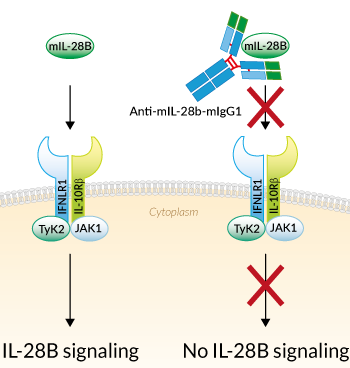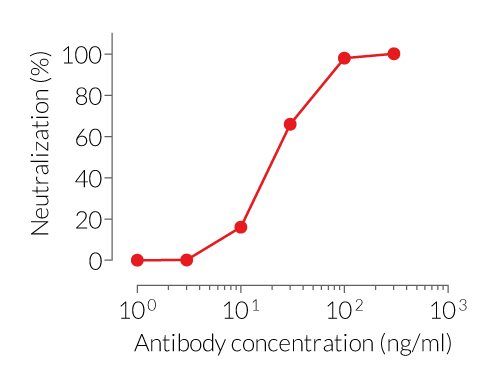Recombinant anti-mouse IL-28b antibody
| Product | Unit size | Cat. code | Docs. | Qty. | Price | |
|---|---|---|---|---|---|---|
|
Anti-mIL-28b-mIgG1 Recombinant mouse mAb against mIL-28B (clone 3C11). For in vitro use. |
Show product |
200 µg |
mil28b-mab9-02
|
|
||
|
Anti-mIL-28b-mIgG1 InvivoFit™ Recombinant mouse mAb against mIL-28B (clone 3C11). For in vivo use. |
Show product |
1 mg |
mil28b-mab9-1
|
Notification: Our anti-mouse IL-28B antibody raised in mice and produced in hybridoma (mabg-mil28b/mabg-mil28b-5) has been removed from our catalog. Its coding sequence has been determined and the antibody is now produced by recombinant technology and purified from CHO cells.
Recombinant mouse IL-28B antibody

Neutralizing monoclonal antibody against murine IL-28B
InvivoGen provides a recombinant fully mouse anti-mouse IL-28b-mIgG1 monoclonal antibody (mAb) that was previously extracted from hybridoma. It is now expressed and produced in Chinese hamster ovary (CHO) cells, ensuring reliability and lot-to-lot reproducibility. Thereby, common hybridoma-related drawbacks such as the generation of non-relevant mAbs containing aberrant light chains are avoided [1].
The sequence of the anti-mIL-28b-mIgG1 is 100% murine (constant and variable regions), as the original clone (clone 3C11) was raised in mice using a proprietary method. This feature allows for reduced immunogenicity and risks of fatal hypersensitivity reactions upon repeated mAb injections into mice [2-4].
InvivoGen provides this antibody in two grades:
- In vitro use: Anti-mIL-28b-mIgG1
- In vivo use: Anti-mIL-28b-mIgG1 InvivoFit™
All InvivoFit™ products are handled in a clean room, filter-sterilized, and tested for bacterial contaminants. Additionally, this grade guarantees low levels of endotoxins (<1 EU/ml). The buffer formulation is specifically adapted for in vivo studies.
Key features:
- Potent and specific neutralizing activity against mIL-28B
- Sequence is 100% murine
- Murine IgG1 isotype (constant region)
- Free from non-relevant mAbs found in hybridoma-based productions
- Produced in animal-free facilities and defined media
- Low aggregation < 5%
- InvivoFit™ grade is available
Anti-mIL-28b-mIgG1 is designed to efficiently neutralize the biological activity of mIL-28B. Interleukin 28B (IL-28B) is a member of the type III interferon (IFN) family, that exhibits several common features with type I IFNs: antiviral and antitumor activity [5,6].
References:
1. Bradbury, A. et al., 2018. When monoclonal antibodies are not monospecific: Hybridomas frequently express additional functional variable regions. mAbs, 10(4), 539–546.
2. Mall C. et al., 2016. Repeated PD-1/PD-L1 monoclonal antibody administration induces fatal xenogenic hypersensitivity reactions in a murine model of breast cancer. Onco Immunol. 5(2):e1075114.
3. Murphy, J.T. et al., 2014. Anaphylaxis caused by repetitive doses of a GITR agonist monoclonal antibody in mice. Blood. 123(14):2172-2180.
4. Belmar N.A. et al., 2017. Murinization and H chain isotype matching of Anti-GITR antibody DTA-1 reduces immunogenicity-mediated anaphylaxis in C57BL/6 mice. J Immunol. 198:4502-4512.
5. Donnelly RP. et al., 2010. Interferon-lambda: a new addition to an old family. J Interferon Cytokine Res. 30(8):555-64.
6. Li M. et al., 2009. Interferon-ls: the modulators of antivirus, antitumor, and immune responses. J. Leukoc. Biol., 86:23-32.
Specifications
Target: Murine IL-28B (mIL-28B)
Specificity: Reacts with murine IL-28A and murine IL-28B
No cross-reactivity with human IL-28A or human IL-28B
Clone: 3C11
Source: CHO cells
Isotype: Murine IgG1, kappa
Control: Murine IgG1 Isotype Control
Formulation of Anti-mIL-28b-mIgG1: Lyophilized from 0.2 µm filtered solution in a sodium phosphate buffer with glycine, saccharose, and stabilizing agents
Formulation of Anti-mIL-28b-mIgG1 InvivoFit™: Lyophilized from 0.2 µm filtered solution in a sodium phosphate buffer with 5% saccharose
Tested applications: Blocking & Neutralization
Quality control:
- These products have been validated using neutralization cellular assays.
- The complete sequence of these antibodies has been verified.
- The absence of bacterial contamination (e.g. lipoproteins and endotoxins) has been confirmed using HEK-Blue™ TLR2 and HEK‑Blue™ TLR4 cells.
- The endotoxin level in Anti-mIL-28b-mIgG1 InvivoFit™ is <1 EU/mg (determined by a LAL assay).
Contents
Please note: each mAb is sold separately.
Anti-mIL-28b-mIgG1
- mil28b-mab9-02: 200 µg, lyophilized
Anti-mIL-28b-mIgG1 InvivoFit™
- mil28b-mab9-1: 1 mg, lyophilized
![]() The product is shipped at room temperature.
The product is shipped at room temperature.
![]() Store lyophilized antibody at -20 °C.
Store lyophilized antibody at -20 °C.
![]() Lyophilized product is stable for at least 1 year.
Lyophilized product is stable for at least 1 year.
![]() Avoid repeated freeze-thaw cycles.
Avoid repeated freeze-thaw cycles.
InvivoFit™
InvivoFit™ is a high-quality standard specifically adapted to in vivo studies. InvivoFit™ products are filter-sterilized (0.2 µm) and filled under strict aseptic conditions in a clean room. The level of bacterial contaminants (endotoxins and lipoproteins) in each lot is verified using a LAL assay and a TLR2 and TLR4 reporter assay.
Back to the topDetails
Type III interferons (IFNs) - also called IFN-λ cytokines - play an essential role within the antiviral response in epithelial barrier tissues. In humans, this family comprises four distinct proteins called IFN-λ1 (IL-29), IFN-λ2 (IL-28A), IFN-λ3 (IL-28B), and the poorly secreted IFN-λ4. In mice, two functional orthologs (IL-28A and IL-28B) have been described [1,2]. IFN-λs are produced by virtually any nucleated cell type. However, the target cell populations of IL-28/IL-29 are restricted and mainly include epithelial cells and hepatocytes [3].
Upon infection, viral RNA is sensed by pattern-recognition receptors (PRRs) including RIG-I and MDA5 [3]. This stimulates the transcription of IFN-λs by IRF1 (IFN regulatory factor 1). Subsequently, IFN-λs bind to a heterodimeric receptor formed by the assembly of IFNLR1 (IFN-lambda receptor 1) and IL10Rβ (IL-10 receptor β). This leads to the recruitment of the Janus kinases, JAK1 and TyK2, and phosphorylation of STAT1 and STAT2. They dimerize and interact with IRF9, forming the so-called ISGF3 complex. ISGF3 translocates into the nucleus and binds to IFN-stimulated response elements (ISRE) within the promoter region of antiviral IFN-stimulated genes (ISG) to regulate their expression [2-3]. Besides its antiviral function, IFN-λ signaling plays also an important role in non-infectious diseases like inflammatory bowel disease and cancer [2].
1. Lazear HM. et al., 2015. Interferon-λ: Immune Functions at Barrier Surfaces and Beyond. Immunity. 43(1):15-28.
2. Witte K.et al., (2010). IL-28A, IL-28B, and IL-29: Promising cytokines with type I interferon-like properties. 21(4), 0–251.
3. Lee S. & Baldridge MT., 2017. Interferon- Lambda: A Potent Regulator of Intestinal Viral Infections. Front Immunol. 8:749.






